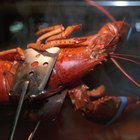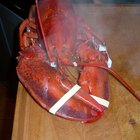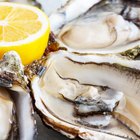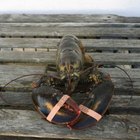Lobsters are one of the few creatures that should be cooked alive however distressing the spectacle might be. To minimize suffering, or the appearance of suffering to be exact, a few simple measures can be applied.
Key Risks
Lobsters, like many other shellfish, naturally contain potentially harmful bacteria in their flesh, one of the reasons they cannot be eaten raw. As soon as the lobster dies, these bacteria multiply rapidly and release toxins that cooking alone will not destroy. Typically, decomposition is rapid in shellfish. As a result, lobsters are nearly always sold live from holding tanks, with their claws bound.
You can only cook dead lobster when the crustacean is dispatched moments before going into the pot, or if it is headed, meaning that the head and thorax have been removed, and the claws and tail were immediately frozen.
Choosing and Storing a Suitable Specimen
A live, healthy lobster moves by reflex when handled, especially the tail. If the lobster’s tail doesn’t spring back beneath the thorax when straightened, and instead hangs limply , the animal is probably dead.
The whiff of ammonia is another indication that the lobster has started to decompose. Fresh lobster should smell faintly briny. Color is less of a guideline. While all cooked lobster finishes with a distinctive red hue, the color can vary before cooking, depending on the species.
Safe Storage
- Cook a lobster on the day of purchase if possible, although the shellfish can survive for up to 36 hours out of water.
- Wrap the lobster in damp newspaper or place it in a container covered with a damp cloth.
- Place the lobster in the refrigerator, ideally on the bottom shelf, to avoid cross-contamination with cooked food.
- Never place lobster in fresh water or on ice, both of which will kill it.
Freezing
Since lobster is a fairly expensive delicacy, the logic of freezing it, and compromising the flavor and texture as a result, is flawed. The proteins in the frozen meat will bond to the shell, making the flesh hard to extract once the lobster is cooked.
- Lobster shouldn’t be frozen live. Rather, blanch it first at 212 degrees Fahrenheit for 60 seconds in salt water, then remove it and cool it immediately under cold running water.
- Seal the lobster in a resealable plastic bag to keep odors in and out, then freeze it.
Shellfish Concerns
A lobster has no brain. Although lobsters will visibly move when coming into contact with boiling water, the movement is a reflex rather than a reaction to pain. According to a landmark Norwegian study, despite their size, lobsters have rudimentary nervous systems that are too simple to feel pain. There may be a muscle reaction, but they feel no emotional distress. A lobster’s nervous system is not much more sophisticated than that of an insect.
Similarly, many people assume that the sound made when a lobster is dunked in boiling water is a scream of pain, which would be quite a feat for a crustacean with neither lungs nor vocal chords. Rather, the sound is air trapped within the shell escaping under pressure as steam.
Preparing Lobster
Cook lobster in seawater or salted fresh water brought to a rolling boil. Pick up the lobster behind the claws, which should still be bound, and drop it headfirst into the boiling water, reducing the heat to a simmer and covering the pot.
Better still, keep as much of the flavor in the lobster by killing it quickly with the knife, then placing in a steaming rack over boiling water.
Related Articles

Difference Between Boiled & Grilled ...

When Does a Lobster Molt?

How to Cook Fully Frozen, Whole Lobster ...

Do Lobsters Make Noise When Being ...

When Is King Crab Season?

How Often Do Lobsters Shed Their ...

How Long Does It Take for ...

How Long Does it Take to Boil Frozen ...

Soaking Shrimp or Scallops in Lime Juice

How to Cook Dead Crab

How to Prepare and Cook Frozen Lobsters

How to Boil 1.5 Pounds of Lobster

How to Boil Lobster at Home

Step-by-Step to Cook a Frozen Lobster

How to Kill a Crab

Does Lobster Taste Better Boiled or ...

How Do I Reheat Leftover Boiled Lobster?

Cooking Methods for Frozen Dungeness ...

How Long After Catching Should You Cook ...

How to Steam Lobster & Shrimp
References
Writer Bio
Nick Marshall is a UK-based writer specializing in trends and best-practice in the B2B sector.